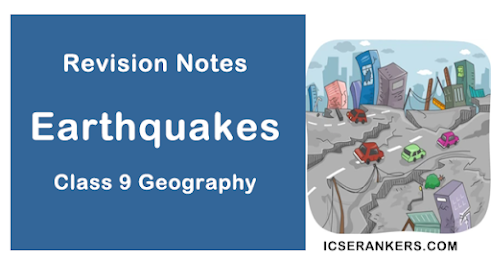ICSE Revision Notes for Earthquakes Class 9 Geography
Chapter Name | Earthquakes |
Topics Covered |
|
Related Study |
Earthquakes
An earthquake is a tremor below the surface of the Earth which causes shaking of the Earth’s crust.
Causes of Earthquake
Earthquakes are generally caused by sudden forces because of the following reasons:
- Plate tectonics: Most of the earthquakes occur because of the movement of tectonic plates. They are caused when two plates either slip past each other or collide against each other. Under such circumstances, their edges produce faults along the lines of weakness.
- Isostatic disturbances: Earthquakes may occur when disturbances are produced by the deposition of sediments by rivers and glaciers on the ocean floor. Because the asthenosphere (the upper layer of the Earth’s mantle) is in the semi-molten state, any disturbance in the equilibrium between oceans and continents may result in movements causing earthquakes.
- Man-made causes: Construction of large dams near the fault zones may result in isostatic movements causing earthquakes.
Anatomy of an Earthquake
- An earthquake is caused by the movement of lithospheric plates inside the surface of the Earth. Because these plates move, the surface of the Earth vibrates. The vibrations can travel all round the Earth.
- The place in the Earth’s crust where the movement first starts is called focus.
- The place on the surface above the focus is called epicentre.
- It is from the epicentre that vibrations in the form of waves travel outwards. These are known as seismic waves.
- The greatest damage and destruction to human life and property occur at places which are closest to the epicentre. The strength of the earthquake decreases as it moves away from the epicentre.
- ∙Earthquake waves are classified into three types. These are:
1. P waves: These are known as primary waves. They pass through solids, liquids and gases. These are the first earthquake waves which can be recorded on a seismogram.
2. S waves: These waves travel through the Earth’s interior but cannot be transmitted by liquids. They are recorded on a seismograph after the P waves.
3. L waves: They are long waves and are recorded after the P and S waves. L waves may be further classified into Love waves and Rayleigh waves.
A seismograph is an instrument which measures and records the details of an earthquake such as its duration, force and direction. The seismograph has a pen attached to it. When an earthquake occurs, the pen also vibrates along with the vibrations produced by the earthquake. The pen records the movements of vibrations on a moving strip of paper. Various waves which are formed by the moving pen give us an estimate of the direction and force of an earthquake. It also calculates the difference in the arrival of P and S waves.
The intensity of an earthquake is measured on the Richter scale and the Mercalli scale. The Richter scale is commonly used for measuring an earthquake. While the Richter scale measures the intensity of the earthquake on a scale from 1 to 9, the Mercalli scale measures it on a 12 point scale. Earthquakes measured above the Richter scale of 6 onwards cause damage to life and property.
Effects of an Earthquake
Earthquakes have constructive and destructive effects.
Constructive Effects
- Earthquakes help the Earth in releasing its energy.
- As a result of earthquakes, many landforms are built. It also results in changing the coastline. Earthquakes in the Himalayan region have resulted in the formation of various lakes. Further, the formation of bays, estuaries and gulfs because of earthquakes has resulted in better navigation.
Destructive Effects
- Earthquakes measuring 6 and above on the Richter scale may result in the loss of human lives. About 15,000 people are killed every year because of earthquakes.
- Earthquakes inflict serious damage to buildings, structures, roads, bridges and railways. Submergence: Many coastal areas get submerged in water because of earthquakes. For example, Dwarka in Gujarat now lies submerged in water.
- Powerful earthquakes may change the course of rivers which may render an area infertile.
- After earthquakes, fire may also break out. This may happen when inflammable material is thrown onto broken gas lines. In the earthquake of 1906 in San Francisco, a great fire broke out which proved to be more destructive than the earthquake itself.
- Tsunamis are caused by earthquakes occurring in the sea. These can cause huge destruction in the coastal regions.
Tsunamis
Tsunamis are long, high waves mainly caused by earthquakes. They can also be caused by volcanic eruption or meteorite impact. An earthquake in the Indian Ocean in 2004 triggered a series of tsunamis on 26 December 2004 in which thousands of people were killed in India, Indonesia Thailand, Malaysia, Sri Lanka and Maldives.
Distribution of Earthquakes
Earthquakes mostly originate from the plate boundaries. There are two main belts where the possibility of the occurrence of an earthquake is the largest.
- The Circum Pacific Mountain Belt: The regions lying in this belt are Japan, the Philippines, Indonesia and California in USA. About 70% of earthquakes originate in this zone.
- The Midway Mountain Belt: This belt extends from Eastern Europe to Asia. It covers the Alpine and Himalayan regions. About 20% of earthquakes originate in this zone.
- The remaining 10% of earthquakes are associated with submarine ridges, ocean floors, rift valleys and other fault zones.
India is located in the Mid-Mountain Belt. The regions in India which are highly prone to earthquakes are Kashmir, the foothills of the Himalayas, the Northeastern region and the Rann of Kachchh. Earthquakes frequently take place in the foothills of the Himalayas and the Ganga Brahmaputra valley as these are the regions where the tectonic plates meet. Maharashtra is also prone to earthquakes.


